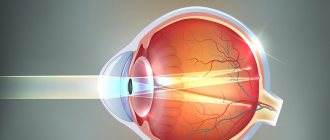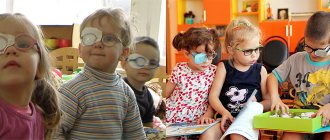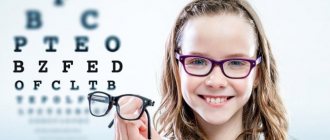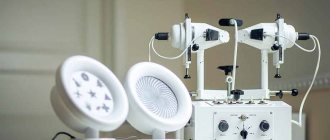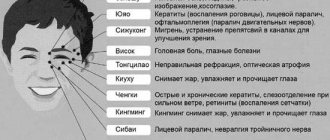Causes Symptoms Diagnostics Treatment Our advantages Treatment price
Amblyopia is a persistent unilateral or bilateral decrease in vision that is not associated with an organic change in the visual analyzer. The peculiarity of amblyopia is the impossibility of its optical correction. The course of the disease can be completely asymptomatic or accompanied by such phenomena as the inability to fix the gaze, impaired color perception and spatial orientation, decreased visual acuity (from slight weakening to light perception).
With amblyopia, otherwise called lazy eye syndrome, one eye is completely or partially excluded from the visual process. In ophthalmology, it is considered as one of the main causes of unilateral vision loss. This disease affects approximately 2% of the world population. Amblyopia is inherent in childhood, therefore, a particularly important aspect is the problem of its early detection and correction of the disease.
Symptoms
What behavior in children indicates amblyopia?
- The child sits close to the TV.
- Children begin to study worse.
- When reading, one eye is able to close and deviate.
- The child rubs his eyes, squints and blinks frequently.
- Complaints of headaches after exercise.
- Clumsy movements of the child.
- When writing, children lean close to the notebook.
- Poor orientation on the terrain.
Prevention
Lazy eye often occurs as a result of strabismus or some other ophthalmic disease. Therefore, the main method of preventing amblyopia is to prevent the development of other eye diseases. You can reduce the likelihood of exclusion of one organ of vision from the visual process if you follow the following recommendations:
- maintain personal eye hygiene;
- Correctly correct visual impairments;
- observe the regime of visual stress;
- perform eye exercises;
- properly organize the workplace;
- Healthy food.
Amblyopia in the early stages of development may be asymptomatic. Regular preventive visits to the ophthalmologist will help to detect the problem in a timely manner.
Author of the article: Kvasha Anastasia Pavlovna, specialist for the website glazalik.ru Share your experience and opinion in the comments.
If you find an error, please select a piece of text and press Ctrl+Enter.
Main types
Amblyopia comes in several types.
- Hysterical amblyopia. This is a temporary loss of visual acuity that occurs during severe nervous tension. Vision deteriorates either partially or disappears completely.
- Dysbinocular amblyopia. It usually appears if the child has strabismus. To successfully get rid of the disease, it is recommended to start treatment as soon as possible.
- Anisometric amblyopia. It occurs due to anisometropia, in which the size of what is seen displayed on the retina is different in the left and right eyes. Creating a single visual image is impossible.
- Deprivation-induced low vision. If a child is born with a cloudy lens and cornea, with ptosis of the upper eyelid and similar pathologies, then giardiaopia occurs. When the lens becomes completely clouded, the child develops a more severe disease – obstructive amblyopia.
- Refractive amblyopia. Occurs when the image is not clearly fixed on the retina. As a result, one eye will seem to turn off, and the other will take on the entire load. The main reason for the development of refractive pathology is the lack of treatment for astigmatism and farsightedness.
Risk factors for developing pathology
- Strabismus - occurs most often, which is caused by prolonged suppression of the picture perceived by the squinting eye as it processes information in the brain.
- Astigmatism or farsightedness is blurred vision in both eyes, which is caused by anisometropia - the phenomenon of unequal refractive indexes. Each eye perceives a different visual wavelength. This type of disease is called refractive amblyopia , and the severity of the disease directly depends on the magnitude of the deviation of the refractive index in the affected eye.
- Cataracts, hemophthalmos, corneal opacities , serious changes in the structure of the vitreous body and other damage that prevent light from reaching the retina.
- Nystagmus is an involuntary movement of the eyeballs of a neurological nature.
- Ptosis is a pathology of the muscles of the adnexa with drooping of the upper eyelid.
Degrees
According to the degree of vision loss, amblyopia is weak (1st degree, 0.4 - 0.8 diopters), moderate (2nd degree, 0.2 - 0.3 diopters), high (3rd degree, 0.05 - 0.1 diopters) and very high (fourth degree, below 0.04 diopters).
Low and moderate amblyopia is difficult to determine even for doctors. High degrees of the disease are diagnosable.
The first “bell” of a high degree of amblyopia is the appearance of clumsiness in a child. Problems with visual fixation and strabismus are also common. Amblyopia can lead to low vision and even disability!
CONJUNCTIVAL DISEASES (H10-H13)
H10 Conjunctivitis Excluded: keratoconjunctivitis (H16.2) H10.0 Mucopurulent conjunctivitis H10.1 Acute atopic conjunctivitis H10.2 Other acute conjunctivitis H10.3 Acute conjunctivitis, unspecified Excluded:
ophthalmia of the newborn NOS (P39.1)H10.4 Chronic conjunctivitisH10.5 BlepharoconjunctivitisH10.8 Other conjunctivitisH10.9 Conjunctivitis, unspecifiedH11 Other diseases of the conjunctivaExcluded: keratoconjunctivitis (H16.2)H11.
0 Pterygium Excludes: pseudopterygium (H11.8)H11.1 Conjunctival degeneration and depositsH11.2 Conjunctival scarsH11.3 Conjunctival hemorrhageH11.4 Other conjunctival vascular diseases and cystsH11.
8 Other specified diseases of the conjunctivaH11.9 Disease of the conjunctiva, unspecifiedH13* Lesions of the conjunctiva in diseases classified elsewhereH13.0* Filarial infestation of the conjunctiva (B74.- )H13.
1* Acute conjunctivitis in diseases classified elsewhereH13.2* Conjunctivitis in diseases classified elsewhereH13.3* Ocular pemphigoid (L12.- )H13.8* Other conjunctival lesions in diseases classified elsewhere
Hardware and drug treatment
Amblyopia must be treated, and the sooner it is done, the better.
Amblyopia in children is treated after eliminating the underlying disease. If refraction is the cause of the disease, then correction with glasses is needed. The doctor prescribes lenses, lutein tablets, and offers laser vision correction. If cataracts, strabismus, and corneal opacity are detected, surgical treatment methods are used. Only after healing from the underlying disease do I begin to treat amblyopia.
For treatment, the healthy eye is closed (occlusion) and drops are prescribed. Hardware treatment is carried out. For example, the procedure of photostimulation of a weak eye, color therapy.
The Sidorenko Glasses device has successfully proven itself for the treatment of low vision in children. These glasses are also very effective in eliminating strabismus. The good news is that the device is also used at home. It is indicated for children over three years of age.
Causes
The causes of amblyopia are very diverse. Most often, a lazy eye is a consequence of strabismus. In this case, the parallelism of the visual axes of the eyes is disrupted, which is why the brain has to turn off one organ of vision from the visual process. Amblyopia can be both a consequence and a cause of strabismus. Lazy eye often occurs due to the following diseases:
- corneal clouding;
- ptosis;
- cataract;
- ophthalmoplegia;
- facial hyperplasia;
- hemophthalmos;
- refractive error.
Often this disease in adults develops as a result of prolonged lack of correction of myopia, hypermetropia or astigmatism. The following factors can also provoke the exclusion of one eye from the visual process:
- wearing incorrectly selected optics;
- genetic predisposition;
- unequal sizes of eyeballs;
- psychosis, hysteria.
Amblyopia is often diagnosed in young children due to incomplete development of the visual system in the first years of life. In this case, the pathology usually resolves on its own as the baby grows older. In other cases, complex treatment is necessary.
Home treatment
Lazy eye syndrome can also be treated at home. Experts have developed a set of exercises. We recommend that parents monitor the child’s correct performance of the exercises and also follow the ophthalmologist’s instructions.
Exercises to treat amblyopia in children at home:
- Place the child in front of the window, let him close his good eye and bring the paper with the text closer to the visually impaired eye until the writing begins to blur. Then you need to slowly move the paper away until the words become “readable” again.
- Glue a black circle of paper with a diameter of up to eight millimeters to an electric lamp (up to seventy watts). Have the child close the seeing eye and look at the light bulb for thirty seconds. Then he turns his gaze to a white sheet of paper previously attached to the wall. The child needs to look at the paper until he sees the outline of a circle from a light bulb.
- For this exercise you need a table lamp with a power of one hundred watts. Put a black paper cap on it and cut a five millimeter hole. After this, cover the hole with red film. Place the child at a distance of forty centimeters from the light bulb, let him look at this red dot with his sore eye for three minutes. You need to turn the lamp on and off every 2-3 seconds.
You need to practice in a dark room, every day, for three months.
Doctors recommend one more exercise, but it is only allowed to be performed once a day. It is as follows: let the child sit down, put his hands on his knees and look straight. Then let him turn his gaze to the left, then down. At the same time, blinking is prohibited. You need to do this exercise until lacrimation begins.
Forecasts
The final prediction of the outcome of the disease, which the doctor can give to the patient, depends on the following conditions:
- Indisputable compliance by the sick person with the recommendations prescribed by the attending physician.
- Diagnosed type of disease.
- Adequacy of eye fixation.
- Initial visual acuity (before illness).
- The age of the sick person at the time of treatment.
- The method of treatment chosen by the doctor.
Amblyopia of the obscuration type, which manifests itself on one side, can affect visual impairment if medical assistance was not provided during the first 3 months of the child’s life. The chances of eventually achieving visual acuity of 0.4 diopters or even higher can only be guaranteed after successful surgery during the first 2 months of life. At the same time, forecasts regarding binocular vision can hardly be called optimistic. Bilateral lesions have the same prognosis, but after the baby reaches six months of age. If treatment is started during a critical period of pathology progression, the prognosis will be disappointing.
Strabismus that remains untreated can cause sensorimotor abnormalities, the most significant of which is considered to be the eccentric type. It is this that has a negative effect on the final outcome and significantly prolongs the duration of treatment.
One of the main conditions is the patient’s undisputed compliance with all medical prescriptions. Timely diagnosis and treatment are of great importance. For example, in a patient over five years old, the likelihood of changing an already present form of strabismus into one that would allow achieving equal visual acuity in both eyes at once is very low.
Without progressive therapeutic correction of strabismus, the fight against amblyopia itself becomes difficult. In such a situation, there is no guarantee that there will be no relapses of the disease in the future, which is why doctors prescribe periodic studies at different times after completion of therapy.
Expert recommendations
- The earlier the syndrome is identified, the more successful the treatment will be.
- Therapy carried out before the child reaches nine years of age is considered effective.
- Even vision at the level of ten percent does not affect the child’s behavior. Only a doctor will make the correct diagnosis and prescribe appropriate treatment.
- It is necessary to show the child to an ophthalmologist as soon as he is one month old. If the baby is premature or born with abnormalities, then it is recommended to carry out the examination even earlier. From four to twelve months the refractive power of the eye should be checked. The norm is slight farsightedness. Then inspections should be carried out once a year.
ICD 10 online
Version 4 (revised 2020)
The International Classification of Diseases is the main classification of diseases by letter codes, which is periodically (once every 10 years) revised under the leadership of WHO. The ICD is a normative document that ensures the unity of methodological approaches and the international comparability of materials.
ICD 10 is used to convert verbal diagnoses of diseases and other health problems into alphanumeric codes that make data easy to store, retrieve, and analyze.
Summary
Parents of children should not neglect the recommendations of doctors and bring their children for examinations on time. If deviations in the behavior of an older child or complaints about vision are noticed, you should immediately consult a doctor. After all, this indicates the presence of amblyopia.
For treatment to be successful, it must begin immediately. Pediatric ophthalmologists agree that treating amblyopia in children is a complex and time-consuming process. Therefore, parents must be persistent, patient and strictly adhere to the instructions of the attending physician.
Diagnostics
These changes are typical for an adult. Kids don’t understand what it’s like to see poorly. They also can’t talk about dizziness. Therefore, it is possible to diagnose the disease in a small child only during a preventive examination. The doctor checks the palpebral fissure, eyelids, eyeball, and fundus.
Next, the reaction to light is determined, tests for refraction and color are carried out, the angle of strabismus is determined, and an ultrasound of the eye is prescribed. An ophthalmologist has many techniques for determining amblyopia. For example, a method such as viziometry checks visual acuity, refractometry reveals myopia, farsightedness, and with them the presence of pathology.
Diagnostics
A remedy for the treatment of glaucoma – Alphagan eye drops.
